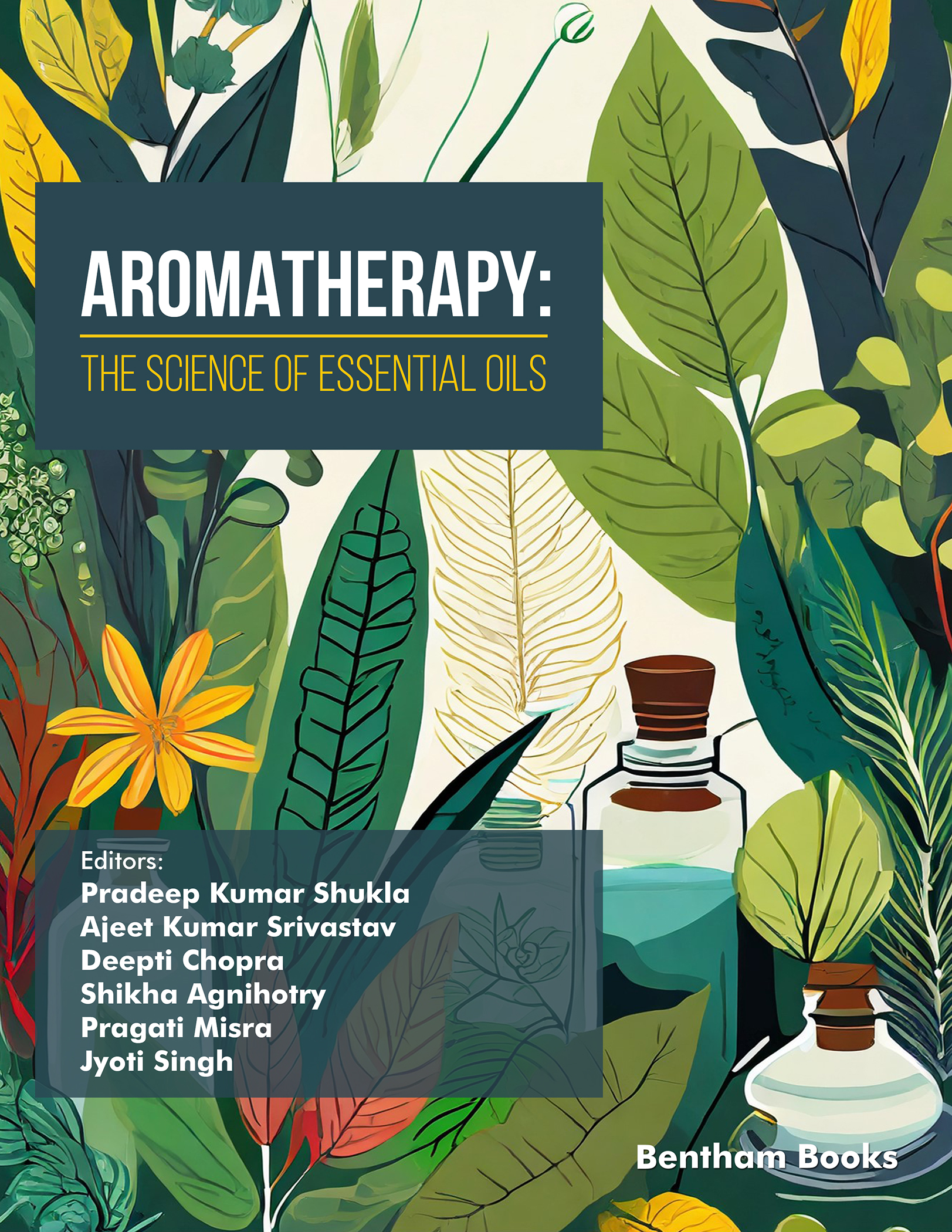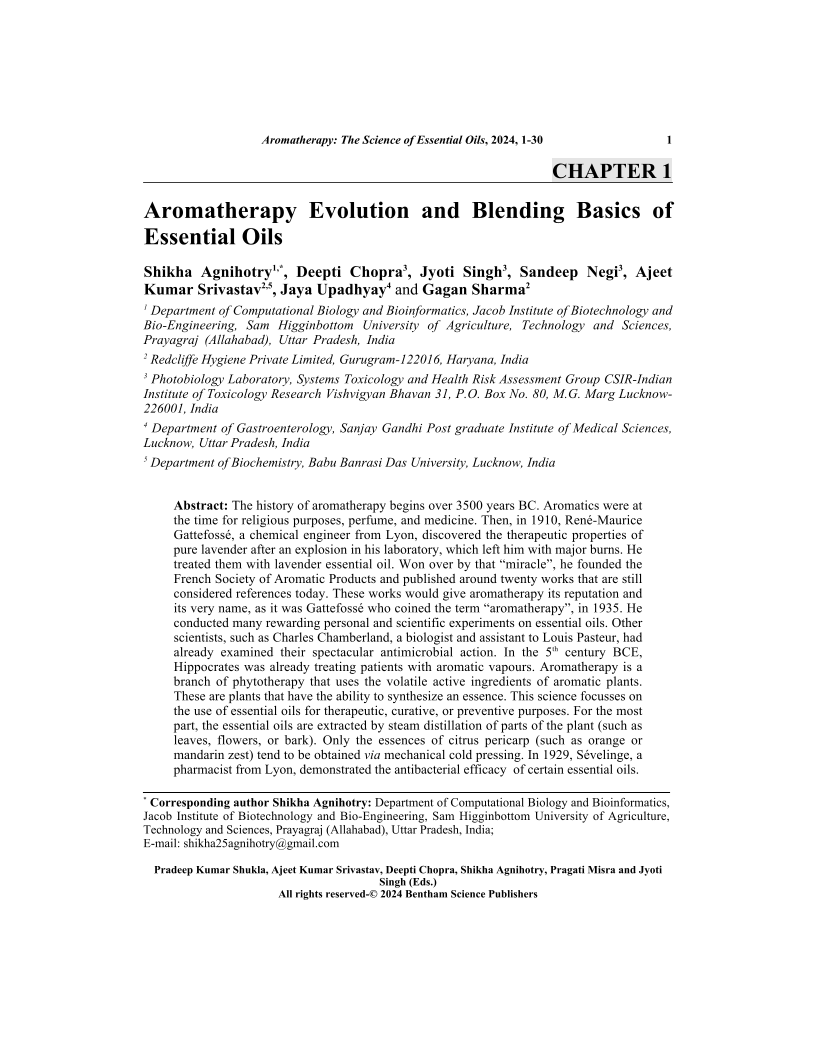Aromatherapy Evolution and Blending Basics of Essential Oils

- Authors: Shikha Agnihotry1, Deepti Chopra2, Jyoti Singh3, Sandeep Negi4, Ajeet Kumar Srivastav5, Jaya Upadhyay6, Gagan Sharma7
-
View Affiliations Hide Affiliations1 Department of Computational Biology and Bioinformatics, Jacob Institute of Biotechnology and Bio Engineering, Sam Higginbottom University of Agriculture, Technology and Sciences, Prayagraj (Allahabad), Uttar Pradesh, India 2 Photobiology Laboratory, Systems Toxicology and Health Risk Assessment Group CSIR-Indian Institute of Toxicology Research Vishvigyan Bhavan 31, P.O. Box No. 80, M.G. Marg Lucknow 226001, India 3 Photobiology Laboratory, Systems Toxicology and Health Risk Assessment Group CSIR-Indian Institute of Toxicology Research Vishvigyan Bhavan 31, P.O. Box No. 80, M.G. Marg Lucknow 226001, India 4 Photobiology Laboratory, Systems Toxicology and Health Risk Assessment Group CSIR-Indian Institute of Toxicology Research Vishvigyan Bhavan 31, P.O. Box No. 80, M.G. Marg Lucknow 226001, India 5 Redcliffe Hygiene Private Limited, Gurugram-122016, Haryana, India 6 Department of Gastroenterology, Sanjay Gandhi Post graduate Institute of Medical Sciences, Lucknow, Uttar Pradesh, India 7 Redcliffe Hygiene Private Limited, Gurugram-122016, Haryana, India
- Source: Aromatherapy: The Science of Essential Oils , pp 1-30
- Publication Date: April 2024
- Language: English
Aromatherapy Evolution and Blending Basics of Essential Oils, Page 1 of 1
< Previous page | Next page > /docserver/preview/fulltext/9789815136203/chapter-1-1.gif
The history of aromatherapy begins over 3500 years BC. Aromatics were at the time for religious purposes, perfume, and medicine. Then, in 1910, René-Maurice Gattefossé, a chemical engineer from Lyon, discovered the therapeutic properties of pure lavender after an explosion in his laboratory, which left him with major burns. He treated them with lavender essential oil. Won over by that "miracle", he founded the French Society of Aromatic Products and published around twenty works that are still considered references today. These works would give aromatherapy its reputation and its very name, as it was Gattefossé who coined the term "aromatherapy", in 1935. He conducted many rewarding personal and scientific experiments on essential oils. Other scientists, such as Charles Chamberland, a biologist and assistant to Louis Pasteur, had already examined their spectacular antimicrobial action. In the 5th century BCE, Hippocrates was already treating patients with aromatic vapours. Aromatherapy is a branch of phytotherapy that uses the volatile active ingredients of aromatic plants. These are plants that have the ability to synthesize an essence. This science focusses on the use of essential oils for therapeutic, curative, or preventive purposes. For the most part, the essential oils are extracted by steam distillation of parts of the plant (such as leaves, flowers, or bark). Only the essences of citrus pericarp (such as orange or mandarin zest) tend to be obtained via mechanical cold pressing. In 1929, Sévelinge, a pharmacist from Lyon, demonstrated the antibacterial efficacy of certain essential oils.Then, in the 1950s, a military physician used them to treat injured soldiers in Indochina. In 1975, Pierre Franchomme, a pharmacologist and aromatologist, brought about decisive progress by proposing that the concept of "chemotype", the "plants true chemical ID card", should be taken into account, listing the key aromatic compounds characterizing each plant and how they affect its properties. Today, aromatherapy is more frequently the focus of scientific studies. It is recognized as a fully-fledged branch of medicine. Over 17,000 articles on aromatherapy have appeared in an international high-level scientific publications.
-
From This Site
/content/books/9789815136203.chapter-1dcterms_subject,pub_keyword-contentType:Journal -contentType:Figure -contentType:Table -contentType:SupplementaryData105

